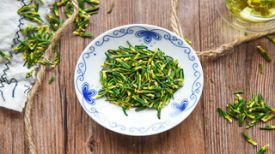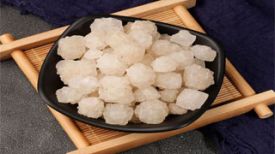Lotus root is favored by the most national treasure level traditional Chinese medicine practitioners and is also a health preserving food highly praised by medical practitioners throughout history. As early as the 5th century BC, the Zhou Dynasty had the position of "food doctor", specializing in the management of dietary nutrition and health care.
Lotus root has various dietary therapeutic effects. Modern scientific analysis shows that lotus root contains a large amount of iron, which has a blood nourishing effect. Its rich vitamin C, antioxidants, polysaccharides, and polyphenols can achieve anti-cancer effects.
In traditional Chinese medicine, raw and cooked lotus roots have different effects. When eaten raw, lotus roots have a sweet and cold taste, which can clear heat and cool blood; After cooking, it has a warm and smooth taste, which helps to strengthen the spleen and stomach. The Compendium of Materia Medica refers to it as the "spiritual root".
Lotus roots are native to India and have been introduced to China for over 3000 years. Common lotus roots are generally divided into two types, namely seven hole lotus root and nine hole lotus root. Seven hole lotus root, also known as safflower lotus root, has a brown yellow outer skin, a short and thick body shape, and a bitter taste when eaten raw; Nine hole lotus root, also known as white flower lotus root, has a smooth outer skin and a silver white color. Its body is thin and long, and raw lotus root tastes crispy, tender, and sweet. Of course, the seven and nine holes are just a rough differentiation method, and not all lotus roots have seven or nine holes.
According to the characteristics of lotus roots, there are slightly different ways to eat them: seven hole lotus roots have a higher starch content, less water, are sticky but not crispy, and are suitable for making soup; Nine hole lotus root has high moisture content, is crispy, tender, and juicy, making it the most suitable for cold or stir frying.
Eating lotus roots raw and cooked has different effects. Raw food can clear heat, stop bleeding, and dispel blood stasis, suitable for people who often have dry mouth, dry tongue, and high heat. The famous five juices of traditional Chinese medicine, including pear juice, water chestnut juice, fresh reed root juice, winter wheat juice, and lotus root juice, are used to remove internal heat, quench thirst, relieve restlessness, nourish yin and moisten the lungs, and quickly replenish physical strength. Raw lotus root also has the effect of clearing the lungs and stopping bleeding, and is commonly used in the early stage to treat pulmonary tuberculosis; And for people who often have nosebleeds, it also has a hemostatic effect; Eating lotus root can achieve the effects of regulating blood, nourishing blood, and rosy complexion for women; Lotus root can also clear the lungs and stop bleeding. It is the best food for tuberculosis patients.
The lotus root itself is also a good medicinal herb, and it is rich in nutrients. Boiling lotus roots with brown sugar has a good effect on vomiting blood, coughing blood, hematuria, rectal bleeding, and uterine bleeding.
The hot summer is the best time to eat lotus roots, which can nourish yin, clear heat, moisturize dryness, quench thirst, and clear the heart and calm the mind. Cold mixed lotus root slices, sweet and sour, crispy and refreshing, spicy and appetizing. The recipe is simple and it is a summer appetizer.
Material:
Lotus root, 20 grams of chili red and pointed, 10 grams of scallions, 15 grams of vinegar, 10 grams of white sugar, and 10 grams of sesame oil.
Production method:
1. Peel, wash, slice lotus roots, add 5 grams of vinegar and a small amount of water to soak, wash red chili peppers and scallions separately, and chop them into small pieces;
2. Pour an appropriate amount of water into the pot and bring to a boil. Put in lotus root slices and cook until cooked. Remove and drain the water, then place on a plate and let it cool;
3. Finally, add 10g of red chili powder, chopped scallions, and seasoning white sugar, vinegar, and sesame oil, and stir well.
When buying lotus roots, it is important to choose ones that are plump, undamaged, non discolored, rust free, and have continuous knots. The smaller the "parrot head" at the top, the better.
When making fresh lotus roots, do not use a raw iron pot, otherwise the fresh lotus roots are prone to discoloration and lose their white and tender color.
After peeling the lotus root, it is prone to discoloration when exposed to air. You can soak it in light vinegar water for 5 minutes and then remove it to keep it white and tender.
When stir frying lotus roots, add some water while stir frying, and the lotus roots will be as white as jade and not easily discolored.
There are many ways to eat lotus root, which can be cooked separately or used as an ingredient. Stewed ribs with fresh lotus root, cold lotus root slices, shredded lotus root with shrimp, shredded lotus root with fish flavor are common eating methods, and can also be made into lotus root meat balls, lotus root dumplings, lotus root Congee, lotus root flour cakes and other patterns.
lotus root
Release time:2024-05-26 10:31:10
Reading:269
Word Count:5161
Subscribe to email


